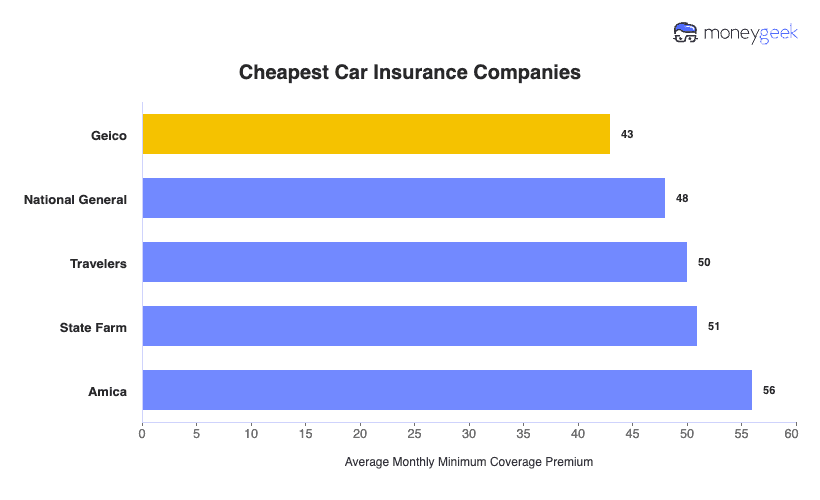The five cheapest car insurance companies nationwide are Progressive at $52, GEICO at $53, Travelers at $54, State Farm at $54 and Nationwide at $76 per month. Progressive offers the lowest rates at 38% below the national median, saving drivers $374 annually. GEICO, Travelers and State Farm cluster tightly together within $2 monthly, but each wins in different coverage scenarios. Travelers leads for full coverage policies, GEICO offers the cheapest liability-only rates, and State Farm provides the lowest costs for high-risk drivers with accidents, tickets or DUIs.
Cheapest Car Insurance Companies in 2026
The cheapest car insurance companies are Progressive, GEICO, Travelers, State Farm and Nationwide, with minimum coverage starting at $43 monthly.
Get the most affordable car insurance company quotes below.

Updated: January 2, 2026
Advertising & Editorial Disclosure
Full Coverage: Travelers, $97/mo
Liability Only: GEICO, $43/mo
Teens: National General, $210/mo
Young Adults: National General, $88/mo
Seniors: GEICO, $83/mo
DUI: State Farm, $73/mo
After an Accident: State Farm, $62/mo
With a Ticket: State Farm, $56/mo
With Poor Credit: Nationwide, $156/mo
Top 5 Cheapest Car Insurance Companies
| Progressive | $52 | $621 | $374 | 38% |
| Geico | $53 | $632 | $363 | 37% |
| Travelers | $54 | $644 | $351 | 35% |
| State Farm | $54 | $650 | $345 | 35% |
| Nationwide | $76 | $918 | $78 | 8% |
*Rates are based on the average of state minimum liability and comprehensive and collision coverage with 100/300/100 limits and a $1000 deductible insuring a 20212 Toyota Camry.
Cheapest Full Coverage Car Insurance Companies
Travelers offers the cheapest full coverage car insurance nationwide at $97 monthly, which is 29% below the national average. GEICO ranks second at $98 monthly, just $1 more than Travelers. Both companies save drivers over $230 annually compared to typical full coverage costs, but Travelers is the least expensive for customers who don't qualify for GEICO's military or federal employee discounts.
Choose full coverage if your vehicle's value exceeds about $4,000, if you're financing or leasing your car, or if you can't afford to replace your vehicle out of pocket. Liability-only makes sense if your car is older or paid off and you have savings to cover repairs or replacement.
| Travelers | $97 | $1,158 | 29% |
| Geico | $98 | $1,177 | 28% |
| National General | $112 | $1,340 | 18% |
| Amica | $115 | $1,381 | 16% |
| State Farm | $121 | $1,448 | 11% |
Cheapest Liability-Only Car Insurance Companies
GEICO offers the cheapest liability-only car insurance nationwide at $43 monthly, which is 36% below the national average and saves drivers $264 annually. National General ranks second at $48 monthly with rates 28% below typical costs. Drivers with assets to protect should consider higher liability limits like 100/300/100. The premium difference is often modest. Compare quotes for both options to determine the actual cost difference before making a decision.
| Geico | $43 | $514 | 36% |
| National General | $48 | $579 | 28% |
| Travelers | $50 | $601 | 25% |
| State Farm | $53 | $634 | 21% |
| Amica | $56 | $669 | 17% |
Cheapest Car Insurance Companies by State
State Farm offers the cheapest rates in 18 states while GEICO leads in 16 states, with the right choice saving you up to $1,943 yearly. Your state's cheapest insurer varies based on local accident rates, weather patterns and state insurance regulations. Check your state in the table below to find which company offers the lowest rates for your coverage level.
| Alabama | Travelers | $47 | $86 | 1% |
| Alaska | Geico | $41 | $87 | 21% |
| Arizona | Travelers | $41 | $83 | 24% |
| Arkansas | Travelers | $41 | $89 | 8% |
| California | Geico | $39 | $91 | 24% |
| Colorado | Geico | $32 | $97 | 30% |
| Connecticut | Geico | $34 | $75 | 46% |
| Delaware | Travelers | $48 | $78 | 38% |
| District of Columbia | Geico | $86 | $152 | 30% |
| Florida | Travelers | $52 | $112 | 26% |
| Georgia | Geico | $40 | $101 | 14% |
| Hawaii | Geico | $24 | $66 | 28% |
| Idaho | State Farm | $18 | $56 | 21% |
| Illinois | Geico | $30 | $69 | 25% |
| Indiana | Geico | $33 | $64 | 8% |
| Iowa | Travelers | $28 | $66 | 9% |
| Kansas | Geico | $25 | $71 | 29% |
| Kentucky | Travelers | $47 | $94 | 18% |
| Louisiana | Geico | $54 | $156 | 21% |
| Maine | Travelers | $28 | $52 | 13% |
| Maryland | Geico | $51 | $89 | 22% |
| Massachusetts | Amica | $35 | $84 | 0% |
| Michigan | Travelers | $25 | $79 | 19% |
| Minnesota | State Farm | $33 | $94 | 4% |
| Mississippi | Travelers | $54 | $105 | 12% |
| Missouri | Travelers | $40 | $81 | 11% |
| Montana | State Farm | $19 | $85 | 34% |
| Nebraska | Geico | $27 | $68 | 0% |
| Nevada | Travelers | $57 | $105 | 24% |
| New Hampshire | Geico | $33 | $61 | 17% |
| New Jersey | Amica | $86 | $152 | 4% |
| New Mexico | Geico | $46 | $95 | 6% |
| New York | Progressive | $34 | $64 | 15% |
| North Carolina | State Farm | $24 | $56 | 33% |
| North Dakota | Geico | $28 | $61 | 9% |
| Ohio | Travelers | $36 | $75 | 1% |
| Oklahoma | Progressive | $29 | $96 | 16% |
| Oregon | Progressive | $46 | $82 | 10% |
| Pennsylvania | Travelers | $30 | $70 | 6% |
| Rhode Island | State Farm | $43 | $88 | 20% |
| South Carolina | Geico | $58 | $112 | 9% |
| South Dakota | Progressive | $14 | $55 | 32% |
| Tennessee | Travelers | $38 | $78 | 15% |
| Texas | State Farm | $41 | $93 | 25% |
| Utah | Geico | $46 | $90 | 23% |
| Vermont | State Farm | $22 | $56 | 23% |
| Virginia | Travelers | $30 | $61 | 15% |
| Washington | Geico | $39 | $96 | 12% |
| West Virginia | Geico | $42 | $92 | 28% |
| Wisconsin | Geico | $20 | $53 | 9% |
| Wyoming | State Farm | $21 | $76 | 21% |
Cheapest Car Insurance Companies for Teens
National General is the cheapest car insurance company for teens, with minimum coverage at $88 monthly—29% below the national average. The company's bridge positioning between standard and non-standard markets allows it to accept young drivers that traditional insurers price out, while its granular underwriting rewards teens on family policies rather than applying blanket youth surcharges.
Full coverage averages $182 per month, making National General the most affordable option for comprehensive and collision protection as well. GEICO follows closely at $94 monthly for liability and $207 for full coverage, delivering competitively low rates through its direct-to-consumer model that eliminates agent commissions.
| National General | $210 | $459 | 13% |
| State Farm | $225 | $444 | 13% |
| Geico | $225 | $477 | 8% |
| Travelers | $237 | $466 | 8% |
Cheapest Car Insurance Companies for Young Adults
National General is the clear leader for young adults looking for cheap coverage. This insurer offers the cheapest average monthly premium for minimum liability coverage, with rates as low as $88 monthly, 29% cheaper than the national average.
For drivers who need comprehensive and collision protection, National General is the cheapest company for full coverage, averaging just $182 per month. GEICO follows closely behind and is budget-friendly choice. It costs $94 monthly for liability and $207 for full coverage.
| National General | $88 | $182 | 29% |
| Geico | $94 | $207 | 21% |
| Travelers | $115 | $228 | 10% |
| State Farm | $123 | $253 | 1% |
Cheapest Car Insurance Insurers for Seniors
GEICO offers the cheapest car insurance for seniors at $83 monthly—13% below the national average for this age group. The company's direct-to-consumer model keeps overhead low while its mature driver discounts and defensive driving course savings stack with multi-policy bundling that many seniors already leverage through homeowners insurance.
National General leads for full coverage at $167 monthly, undercutting competitors by accepting seniors that traditional insurers price into higher brackets. GEICO's $171 monthly full coverage follows just $4 behind, making the choice between National General's competitive pricing through agent networks versus GEICO's digital-first convenience with 24/7 phone support.
| Geico | $83 | $171 | 13% |
| Amica | $89 | $187 | 6% |
| National General | $90 | $167 | 12% |
| State Farm | $95 | $189 | 3% |
Cheapest Auto Insurance Companies for High Risk Drivers
Drivers with accidents, speeding tickets or DUIs pay higher premiums, but State Farm offers the lowest rates for drivers with violations by treating them as pricing anomalies within a diversified risk pool rather than routing them to expensive non-standard divisions. The company charges 23% to 29% below competitors across violation types, absorbing high-risk drivers into its massive policyholder base where their premiums average out against millions of clean-record customers.
- At-Fault Accident: State Farm charges $62 monthly for minimum coverage and $141 for full coverage—23% below the national average.
- Speeding Ticket (11-15 MPH Over): Minimum coverage costs $56 monthly with State Farm, 18% below average rates. Travelers offers competitive pricing at $63 monthly.
- DUI Conviction: State Farm remains the most affordable option at $73 monthly for minimum coverage and $159 for full coverage—29% below average. Travelers and Progressive also offer competitive rates for drivers with DUIs.
Cheapest Auto Insurance Companies for Drivers With Bad Credit
Poor credit can significantly impact your car insurance rates. Insurers use credit scores to assess risk, and drivers with bad credit pay much higher rates. Nationwide is the most affordable company for drivers with bad credit, with premiums starting at $165 monthly. The company undercuts typical rates by 29 percent, saving drivers $1,974 annually compared to the national average.
| Nationwide | $165 | $164 | 29% |
| Farmers | $179 | $203 | 17% |
| GEICO | $183 | $195 | 18% |
| Travelers | $190 | $208 | 14% |
| Allstate | $214 | $227 | 4% |
In states where credit-based insurance scoring is legal, poor credit (scores below 580) will increase premiums by about 100%. California, Hawaii, and Massachusetts prohibit insurers from using credit scores in rate calculations. Compare quotes from multiple insurers to find the cheapest option for your credit situation.
Cheap Car Insurance Companies: Buying Guide
Insurance companies price identical coverage anywhere from $1,200 to $8,500 differently depending on whether you're a teen driver, carry violations, own multiple vehicles, or have poor credit. The right carrier for your situation, combined with strategic discount stacking, delivers 20% to 40% lower premiums than advertised base rates, with regional insurers frequently undercutting national carriers by 28% to 34% in markets where they concentrate operations.
How to Find the Most Affordable Car Insurance Company for You
The cheapest car insurance company depends on your driver profile and coverage needs. MoneyGeek's analysis of auto insurance shopping trends reveals that good drivers in expensive markets experience price gaps exceeding $1,200 annually between the cheapest and most expensive insurers for identical coverage, with shopping activity surging 19% year-over-year as Americans realize that loyalty can cost thousands in unnecessary expenses. Use these five strategies to identify which insurer offers the best rates for your situation:
- 1Match Your Driver Profile to Specialized Insurers
Identify your category: teen, young adult, senior, military member, or high-risk driver. Then focus on companies that offer the cheapest rates in your demographic. Each insurer prices differently by driver type, so specialization matters.
- 2Compare Regional vs. National Companies
Check if regional companies operate in your state. Regional insurers often offer rates 28 to 34 percent below national averages in specific markets. Availability varies by location, so the cheapest option may be regional rather than a national carrier. While regional carriers often offer lower pricing, they offer less coverage option and may not have easy digital claims processes.
- 3Evaluate Each Company's Discount Programs
Discount programs vary widely between insurers—State Farm emphasizes bundling discounts (10-25% off) for homeowners and households with multiple vehicles, while GEICO targets military members, federal employees, and low-mileage drivers. Common discounts include good student (15-25%), safe driver (20-30%), and multi-policy savings.
- 4Review Company Pricing by Coverage Type
Get quotes for the coverage level you need. Some insurers offer better rates for minimum liability, while others have lower rates than the competition for full coverage. Use state comparison tables and MoneyGeek's car insurance calculator to estimate costs before requesting formal quotes.
- 5Check State-Specific Company Performance
The cheapest company changes by state. State Farm offers the lowest rates in 18 states, while GEICO leads in 16. Nationwide, Progressive, Farmers, Allstate and Travelers are lower priced specific regional markets. Use state comparison tables to identify which company performs best in your state.
- 6Consider Raising Your Deductible
Your deductible is the amount you pay out of pocket before your insurance coverage kicks in. Choosing a higher deductible reduces your monthly premium because you're assuming more of the financial risk. The trade-off is paying more if you have an accident. Raising your deductible from $500 to $1,000 will save you up to 20% on your policy.
Best Car Insurance Company Discounts to Lower Premiums
The cheapest car insurance company isn't determined by advertised rates or market share—it's determined by how well an insurer's business model and discount structure align with your specific driver profile. Young drivers save most with Travelers' youth-focused programs, high-risk drivers find lowest rates through State Farm's forgiving violation pricing, multi-car families benefit from GEICO's stackable household discounts, and poor credit drivers pay dramatically less through Nationwide's credit-light underwriting.
Clean Record | Travelers | $97 | $1,158 | Policy bundle (13%) + Safe driving (10%) | $75 |
Clean Record | GEICO | $98 | $1,177 | Multiple vehicles (25%) + Home policy (25%) | $73 |
Teen Driver | State Farm | $444 | $5,328 | Academic achievement (25%) + Steer Clear | $333 |
Teen Driver | Travelers | $466 | $5,592 | Student discount (25%) + IntelliDrive (30%) | $256 |
Young Adult | National General | $182 | $2,184 | Household policies combined | $155 |
Young Adult | GEICO | $207 | $2,484 | Student rate (15%) + Clean record (22%) | $153 |
Senior (60+) | National General | $167 | $2,004 | Mature driver course (10%) + Policy bundle (25%) | $125 |
Senior (60+) | GEICO | $171 | $2,052 | Safety course (10%) + Home/auto bundle (25%) | $128 |
High-Risk (DUI) | State Farm | $159 | $1,908 | Monitored driving (20%) + Policy bundle (17%) | $127 |
High-Risk (DUI) | Progressive | $161 | $1,932 | Snapshot safe driving program | $142 |
Poor Credit | Nationwide | $164 | $1,968 | SmartRide usage-based (40%) + Multi-policy | $115 |
Poor Credit | GEICO | $195 | $2,340 | Combined policies (25%) + Violation-free (22%) | $137 |
Descriptions of the Best Car Insurance Discounts
- Telematics-based insurance: Usage-based programs like Progressive's Snapshot and State Farm's Drive Safe & Save monitor your driving habits through a mobile app or plug-in device, with safe drivers earning discounts averaging $231 annually. These programs work particularly well for cautious drivers who want their rates to reflect actual behavior rather than demographic assumptions.
- Good student discount: Full-time students maintaining a B average or higher qualify for savings ranging from 15% to 25% off their premium. You'll need to provide report cards or transcripts to verify eligibility.
- Multi-vehicle discount: Insuring multiple cars with the same company reduces each vehicle's premium by up to 25%. The discount applies because insurers save on administrative costs and view multi-car households as more stable, lower-risk customers.
- Bundling discount: Combining auto insurance with homeowners or renters coverage from the same insurer generates savings of 10% to 25% on both policies. Beyond the immediate cost reduction, bundling simplifies billing and claims management by keeping all coverage under one provider.
- Safe driver discount: Maintaining a clean driving record for three to five years without accidents or violations earns you discounts of 20% to 30% on most coverage types. Insurers view your history as the strongest predictor of future claims, so drivers who avoid tickets and accidents benefit from consistently lower rates.
- Military and federal employee programs: Active duty military, veterans, and federal employees access specialized discounts of 12% to 15% through companies like GEICO and USAA. These programs often include additional benefits like deployment storage options that suspend coverage during overseas assignments.
- Loyalty rewards: Long-term customers earn benefits like accident forgiveness, vanishing deductibles, and rate reductions for staying with the same insurer for multiple years. Progressive offers decreasing deductibles that drop $50 per policy period without claims, while Amica provides dividend payments to policyholders.
Cheapest Auto Insurance Companies: Bottom Line
The most economical car insurance company varies by individual circumstances, but GEICO offers competitive rates across multiple driver profiles. Travelers provides excellent value for full coverage at $97/month. Learning how to switch car insurance companies makes transitioning to a cheaper car insurance provider straightforward.

Ensure you're getting the most affordable rate for your auto insurance. Compare budget-friendly quotes from the top auto insurers.
FAQs About the Cheapest Insurers
We answer common questions about saving money on car insurance to help you find the cheapest policy:
Is Cheap Car Insurance Worth It?
Finding affordable coverage is budget-friendly, but the absolute lowest price does not always provide the best value. Companies offering lower rates may cut corners when you need to file a claim.
Be aware of slow claims processing, limited customer service, and fewer coverage options. Your policy covers damage only up to your limit, meaning you remain responsible for anything beyond that amount in a serious accident. Remember that insurance fraud costs the average family between $400 and $700 per year in premiums.
How can I find the cheapest car insurance in my state?
Shopping around is the best way to find the cheapest car insurance company no matter where you live. GEICO has the lowest rates for most states and drivers. The most affordable insurer for you depends on your unique profile, so compare quotes from multiple cheap car insurance companies.
What's the lowest you can pay for car insurance?
Minimum coverage policies meeting your state's requirements are typically the cheapest car insurance available. GEICO's minimum coverage rates start at $43 per month, though your actual rate depends on your location and driver profile.
Which states have the cheapest car insurance?
Maine, Vermont and Idaho have the lowest car insurance rates due to lower population density, fewer claims and favorable regulations.
Can bundling policies reduce the cheapest car insurance rates?
Bundling auto and home insurance with the same company provides 10% to 25% discounts, making it one of the most effective ways to reduce your car insurance rates.
Affordable Auto Insurance Rates: Related Pages
About Mark Fitzpatrick

Mark Fitzpatrick, a Licensed Property and Casualty Insurance Producer, is MoneyGeek's resident Personal Finance Expert. He has analyzed the insurance market for over five years, conducting original research for insurance shoppers. His insights have been featured in CNBC, NBC News and Mashable.
Fitzpatrick holds a master’s degree in economics and international relations from Johns Hopkins University and a bachelor’s degree from Boston College. He's also a five-time Jeopardy champion!
He writes about economics and insurance, breaking down complex topics so people know what they're buying.
sources
- Centers for Disease Control and Prevention. "Risk Factors for Teen Drivers." Accessed June 27, 2025.
- Centers for Disease Control and Prevention. "Older Adult Drivers." Accessed June 27, 2025.









